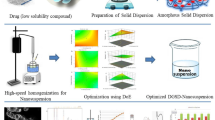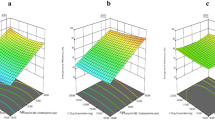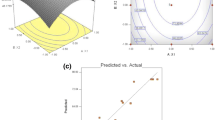Abstract
Efavirenz (EFV) is one of the first-line antiretroviral drugs recommended by the World Health Organisation for treating HIV. It is a hydrophobic drug that suffers from low aqueous solubility (4 μg/mL), which leads to a limited oral absorption and low bioavailability. In order to improve its oral bioavailability, nano-sized polymeric delivery systems are suggested. Spray dried polycaprolactone-efavirenz (PCL-EFV) nanoparticles were prepared by the double emulsion method. The Taguchi method, a statistical design with an L8 orthogonal array, was implemented to optimise the formulation parameters of PCL-EFV nanoparticles. The types of sugar (lactose or trehalose), surfactant concentration and solvent (dichloromethane and ethyl acetate) were chosen as significant parameters affecting the particle size and polydispersity index (PDI). Small nanoparticles with an average particle size of less than 254 ± 0.95 nm in the case of ethyl acetate as organic solvent were obtained as compared to more than 360 ± 19.96 nm for dichloromethane. In this study, the type of solvent and sugar were the most influencing parameters of the particle size and PDI. Taguchi method proved to be a quick, valuable tool in optimising the particle size and PDI of PCL-EFV nanoparticles. The optimised experimental values for the nanoparticle size and PDI were 217 ± 2.48 nm and 0.093 ± 0.02.



Similar content being viewed by others
References
Antiretroviral therapy for HIV infection in adults and adolescents: recommendations for a public health approach—2010 revision. http://whqlibdoc.who.int/publications/2010/9789241599764_eng.pdf. Accessed 25 May 2012
Bendell A, Disney J, Pridmore WA (1989) Taguchi methods: applications in world industry. IFS Publications, UK
Chiappetta DA, Hocht C, Taira C, Sosnik A (2010) Efavirenz-loaded polymeric micelles for pediatric anti-HIV pharmacotherapy with significantly higher oral bioavailability. Nanomedicine 5:11–23
Chiappetta DA, Hocht C, Taira C, Sosnik A (2011) Oral pharmacokinetics of the anti-HIV efavirenz encapsulated within polymeric micelles. Biomaterials 32:2379–2387
Destache CJ, Belgum T, Christensen K, Shibata A, Sharma A, Dash A (2009) Combination antiretroviral drugs in PLGA nanoparticle for HIV-1. BMC Infect Dis 9:198
Destache CJ, Belgum T, Goede M, Shibata A, Belshan MA (2010) Antiretroviral release from poly(DL-lactide-co-glycolide) nanoparticles in mice. J Antimicrob Chemother 65:2183–2187
Govender T, Ojewole E, Naidoo P, Mackraj I (2008) Polymeric nanoparticles for enhancing antiretroviral drug therapy. Drug Delivery 15:493–501
Heng K, Ogawa DJ, Cutler HK, Chan JA, Raper, Ye L et al (2009) Pure drug nanoparticles in tablets: what are the dissolution limitations? J Nanopart Res 12:1743–1754
Ilium L, Davis SS, Wilson CG (1982) Blood clearance and organ deposition of intravenously administered colloidal particles. The effects of particle size, nature and shape. Int J Pharm 12:135–146
Jahanshahi M, Sanatiand MH, Babaei Z (2008) Optimization of parameters for the fabrication of gelatin nanoparticles by the Taguchi robust design method. J Appl Statistics 35:1345–1353
Kateb B, Chiu K, Black KL, Yamamoto V, Khalsa B, Ljubimova JY, Ding H, Patil R, Portilla-Arias JA, Modo M, Moore DF, Farahani K, Okun MS, Prakash N, Neman J, Ahdoot D, Grundfest W, Nikzad S, Heiss JD (2011) Nanoplatforms for constructing new approaches to cancer treatment, imaging, and drug delivery: what should be the policy? NeuroImage 54:S106–S124
Kho K, Cheow WS, Lie RH, Hadinoto K (2010) Aqueous redispersibility of spray dried antibiotic-loaded polycaprolactone nanoparticles aggregrate for inhaled anti-biofilm therapy. Powder Technol 203:432–439
Kim KD, Choi DW, Choa YH, Kim HT (2007) Optimization of parameters for the synthesis of zinc oxide nanoparticles by Taguchi robust design method. Colloids Surf A 311:170–173
Kovochich M, Marsden MD, Zack JA (2011) Activation of latent HIV using drug-loaded nanoparticles. PLoS ONE 6(4):e18270. doi:10.1371/journal.pone.0018270
Lee SH, Heng D, Ng WK, Chan H, Tan RBH (2011) Nano spray drying: a novel method for preparing protein nanoparticles for protein therapy. Int J Pharm 403:192–200
Mamo Tewodros, Moseman E Ashley, Kolishetti Nagesh, Salvador-Morales Carolina, Shi Jinjun, Kuritzkes Daniel R, Langer Robert, von Andrian Ulrich, and Farokhzad Omid C (2010) Emerging nanotechnology approaches for HIV/AIDS treatment and prevention. Nanomedicine (Lond) 5(2): 269–285
Marzolini C, Telenti A, Decosterd LA, Greub G, Biollaz J, Buclin T (2001) Efavirenz plasma levels can predict treatment failure and central nervous system side effects in HIV-1-infected patients. AIDS 15:71–75
Neves JD, Amiji MM, Bahia MF, SARMANTO B (2010) Nanotechnology-based systems for the treatment and prevention of HIV/AIDS. Adv Drug Deliv Rev 62:458–477
Nowacek AS, Balkundi S, McMillan J, Roy U, Martinez-Skinner A, Mosley RL, Kanmogne G, Kabanov AV, Bronich T, Gendelman HE (2011) Analyses of nanoformulated antiretroviral drug charge, size, shape and content for uptake, drug release and antiviral activities in human monocyte-derived macrophages. J Controlled Release 150:204–211
Palmieri GF, Wehrle P (1997) Evaluation of ethylcellulose-coated pellets optimized using the approach of Taguchi. Drug Dev Ind Pharm 23:1069–1077
Pediatric Guidelines (2011) Panel on antiretroviral therapy and medical management of HIV-infected children. Guide-lines for the use of antiretroviral agents in pediatric HIV infection. August 11; pp 1–268. Available at http://aidsinfo.nih.gov/ContentFiles/lvguidelines/PediatricGuidelines.pdf.(Accessed 25 May 2012)
Prasanna L, Giddam AK (2010) Nano-suspension technology: a review. Int J Pharm Pharm Sci 2:35–40
Santos-Magalhães NS, Mosqueira VC (2010) Nanotechnology applied to the treatment of malaria. Adv Drug Deliv Rev 62:560–575
Schubert MA, Goymann-Müller CC (2005) Characterisation of surface-modified solid lipid nanoparticles (SLN): influence of lec-ithin and non-ionic emulsifier. Eur J Pharm Biopharm 61:77–86
Semete B, Booysen L, Lemmer Y, Kalombo L, Katata L, Verschoor J, Swai H (2010a) In vivo evaluation of the biodistribution and safety of PLGA nanoparticles as drug delivery systems. Nanomedicine: NBM 6:662–671
Semete B, Kalombo L, Katata L, Swai H (2010) Nano-drug delivery systems: Advances in TB, HIV and Malaria treatment. Smart Biomol. Medicine book In press, Chapter 2
Shah LK, Amiji MM (2006) Intracellular delivery of saquinavir in biodegradable polymeric nanoparticles for HIV/AIDS. Pharm Res 23:11
Sharma P, Gaeg S (2010) Pure drug and polymer based nanotechnologies for the improved solubility, stability, bioavailability and targeting of anti-HIV drugs. Adv Drug Deliv Rev 62:491–502
Varshosaz J, Tavakoli N, Minayian M, Rahdari N (2009) Applying the Taguchi design for optimized formulation of sustained release gliclazide chitosan beads: An In Vitro/In Vivo Study,AAPS PharmSciTech; 10 doi: 10.1208/s12249-009-9191-8
WHO (2010) Antiretroviral therapy for HIV infection in adults and adolescents: recommendations for a public health approach– 2010 revision http://whqlibdoc.who.int/publications/2010/9789241599764_eng.pdf (Accessed 25 May 2012)
Acknowledgments
The authors would like to thank CSIR Young Researcher’s Fund and South African Department of Science and Technology for providing financial support for the work presented in this paper. Dr James Wesley-Smith is acknowledged for the TEM analysis of the nanoparticles.
Author information
Authors and Affiliations
Corresponding author
Electronic supplementary material
Below is the link to the electronic supplementary material.
Rights and permissions
About this article
Cite this article
Katata, L., Tshweu, L., Naidoo, S. et al. Design and formulation of nano-sized spray dried efavirenz-part I: influence of formulation parameters. J Nanopart Res 14, 1247 (2012). https://doi.org/10.1007/s11051-012-1247-0
Received:
Accepted:
Published:
DOI: https://doi.org/10.1007/s11051-012-1247-0




